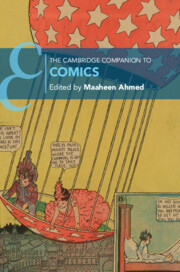Book contents
- The Cambridge Companion to Comics
- The Cambridge Companion to Comics
- Copyright page
- Contents
- Figures
- Contributors
- Acknowledgments
- Chronology
- Introduction
- Part I Forms
- Part II Readings
- Chapter 6 Comics and Multimodal Storytelling
- Chapter 7 Comics Adaptations
- Chapter 8 Comics Genres
- Chapter 9 Life Writing in Comics
- Chapter 10 Racialines
- Chapter 11 Women and Comics
- Chapter 12 Comics at the Limits of Narration
- Part III Uses
- Further Reading
- Index
- Cambridge Companions To …
- References
Chapter 9 - Life Writing in Comics
from Part II - Readings
Published online by Cambridge University Press: 17 August 2023
- The Cambridge Companion to Comics
- The Cambridge Companion to Comics
- Copyright page
- Contents
- Figures
- Contributors
- Acknowledgments
- Chronology
- Introduction
- Part I Forms
- Part II Readings
- Chapter 6 Comics and Multimodal Storytelling
- Chapter 7 Comics Adaptations
- Chapter 8 Comics Genres
- Chapter 9 Life Writing in Comics
- Chapter 10 Racialines
- Chapter 11 Women and Comics
- Chapter 12 Comics at the Limits of Narration
- Part III Uses
- Further Reading
- Index
- Cambridge Companions To …
- References
Summary
This chapter examines life writing in comics through the influential zine King-Cat Comics and Stories, created and independently self-published by John Porcellino since 1989. The various forms of expression employed in King-Cat generate a kind of unmediated directness between Porcellino and the reader, where the mode of address, tone, and style is constantly modulating. King-Cat is a form of life writing that uses the zine format and, in this case, comics featured within the zine, to foreground its aporetic nature. Constantly making the reader switch gears between different kinds of information in different forms, King-Cat makes the aporetic experience almost second nature for the reader. The intra- and intertextual dynamics created by Porcellino’s life writing practice implicate the reader in an animistic medium of uncertainty, where what the text “asks” of the reader shifts in register even in sections of the same page. This kind of reading process challenges traditional linear notions of time and suspends the location of identity within a text, thus suggesting a dynamic communal vision for life writing and, perhaps, for viewing life itself.
- Type
- Chapter
- Information
- The Cambridge Companion to Comics , pp. 185 - 203Publisher: Cambridge University PressPrint publication year: 2023



